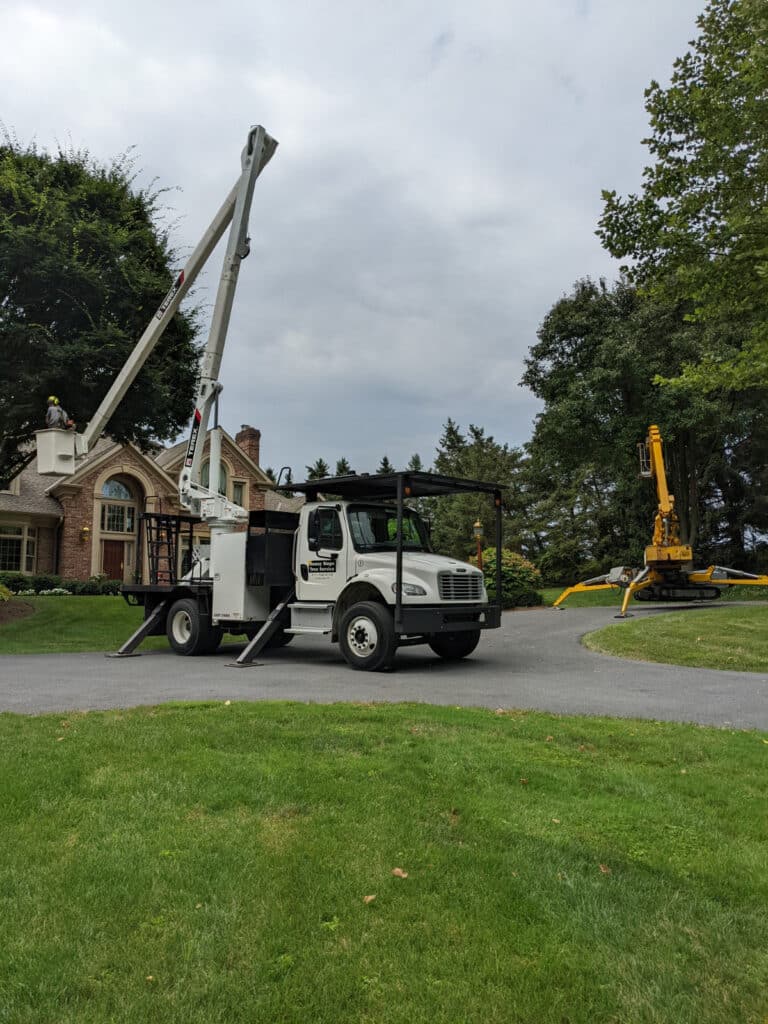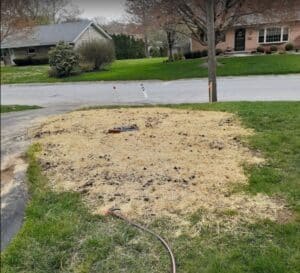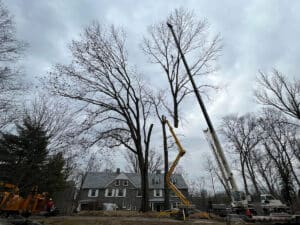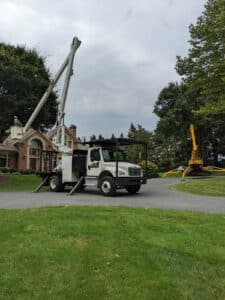The Quick Answers Up Front
- Healthy trees can be close to a house, but large mature trees always bring some risk. Tree roots and root systems can damage a house’s foundation if not monitored carefully. Too much shade from nearby shade trees can lead to moisture and mold problems inside the home.
- Limbs touching a roof will cause damage and should be pruned back, at least 10 feet away.
- Choosing the right tree species and planting it in the right location is key to keeping your foundation safe.
One of the more common questions we hear from homeowners when we’re called out to look at a project is: “How close can a tree be to a house?” The truth is, there’s no one measurement that works for every situation. The answer depends on the health of the tree, the type of tree species, how its roots spread underground, and how the soil conditions affect growth.
At Sunny Slope Tree Service, we’ve been helping Lancaster County families evaluate trees near a house for decades. Our goal is always to keep your property, your yard, your house’s foundation, and your peace of mind safe.

When Is a Tree Too Close to a House?
First, this isn’t about regulations.
Pennsylvania doesn’t set any laws for how many feet away trees should be planted from a house.
Instead, we look at the condition of each tree. Healthy medium sized trees or small flowering trees planted with care generally don’t pose major risks. But large mature trees towering 40 feet tall or more over a roof can become a real safety hazard, especially if they’re planted in the wrong place or have extensive root systems growing toward the home’s foundation walls. From our perspective, every location is unique and requires a careful look at both the canopy above and the roots beneath the ground.
The Hidden Risks of Shade and Moisture
Not all tree dangers are obvious. We’ve seen cases where shade trees were planted too close to a home, blocking sunlight all day. While the canopy kept the yard cooler, it also created serious mold issues inside the home by trapping moisture against the walls and roof.
A shade tree can be a wonderful feature in your landscape, but it needs to be planted in the right place! Otherwise, what seems like beauty and curb appeal can turn into an expensive repair job for your siding or home’s foundation.
Warning Signs Your Tree Is Too Close
From our experience, these are the red flags that a tree is too close to your home:
- Dead trees, rotten limbs, or holes in the trunk when it’s near the home.
- Leaning structure or weak branching that increases the chance a tree falls.
- Tree roots growing toward the home’s foundation, underground lines, or utility lines.
- Dead branches brushing or hanging over the roof.
- Softwood tree species like poplar or pine, known to shed branches more often.
- Trees growing in poor soil conditions or wet ground, which makes them more likely to uproot and fall during storms.
What About Roof Damage From Tree Limbs?
One of the most immediate risks of having trees near a house is roof damage.
Even healthy trees can cause problems if branches touch the shingles. On a windy day, those branches scrape against the roof, slowly damaging the shingles or metal and weakening it over time. We always recommend keeping at least 10 feet of clearance between the roof and any branches. Regular pruning is one of the simplest ways to prevent roof repairs.
So, What’s The Safe Distance?
There isn’t a universal rule for exactly how close a tree should be to your house, but here are some best practices we share with customers:
- Keep branches pruned back at least 10 feet away from your house.
- Inspect large mature trees that are within falling distance of your property.
- Remove dead trees or any tree that poses a safety hazard close to your home.
- When you plant new trees, give them space from utility lines, underground lines, and your house’s foundation. Think about their mature size, spread, and maximum height before planting.
- Avoid planting the wrong tree in the wrong place; choose the right tree for your soil conditions, your landscape, and your foundation safe.
Some Final Advice From Our Team
In the end, the health and structure of the tree — and how its roots grow — matter more than the exact distance.
Most trees add curb appeal and natural beauty to a yard, but any tree close to your home needs regular attention. Large mature trees, especially those with extensive root systems, carry more risk near a house’s foundation. Smaller ornamental or medium sized trees are usually less of a concern.
Our best advice: if you’re concerned a tree is too close to your home, it’s worth having us take a look so you can plant trees wisely and keep your foundation safe.
If you’re worried a tree is too close to your home or you’ve noticed tree roots spreading toward your foundation, don’t wait until it becomes a safety hazard. Call Sunny Slope Tree Service today, your Lancaster PA tree service company. We’ll evaluate your existing trees, explain whether they pose risks, and recommend the right steps — whether that’s trimming, pruning, or removal — to keep your property, landscape, foundation, and family safe for years to come.





